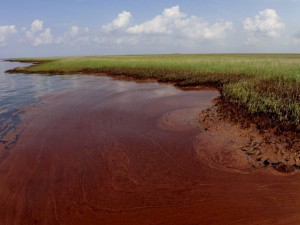Here’s another posting that got lost in theOilDrum.com comment thread Deepwater Oil Spill – A Longer Term Problem, Personnel – and Open Thread 2
I’ve corrected a few factual errors, and those corrections will appear in […] in the quote body, and I’ve also cleaned up the links/quotes to make them more readable. Other than that all content is as it appeared Saturday night. Please note that the original source for this was as far as I can tell on godlikeproductions.com/forum1/ – The BP Deep water horizon, Macondo Well Blowout. and what we are facing in the Gulf Part II
A similar discussion/posting of a casing failure can be found at nakedcapitalism.com – Guest Post: BP Official Admits to Damage BENEATH THE SEA FLOOR, June 12 2010, with relevant quotes and support arguments.
Also, you have to wonder if this is what Matt Simmons (Oil Guru: The Real Nightmare Will Be When A Hurricane Picks Up The Oil And Paints The Gulf Coast Black, and theOilDrum.com – Matt Simmons on Dylan Ratigan Today, Closing the Relief Ports, and Open Thread 2) and Florida senator Bill Nelson (Sen. Bill Nelson: Reports of oil seeping up from seabed, well casing may be pierced. (video) ), were talking about recently, albeit in a distorted form?
Also please make sure to read the discussion I’ve posted under this main article/posting that looks at some of the key points from a technical perspective.
dougr on June 13, 2010 – 3:17am Permalink | Subthread | Comments top
OK let’s get real about the GOM oil flow. There doesn’t really seem to be much info on TOD that furthers more complete understanding of what’s really happening in the GOM.
As you have probably seen and maybe feel yourselves, there are several things that do not appear to make sense regarding the actions of attack against the well. Don’t feel bad, there is much that doesn’t make sense even to professionals unless you take into account some important variables that we are not being told about. There seems to me to be a reluctance to face what cannot be termed anything less than grim circumstances in my opinion. There certainly is a reluctance to inform us regular people and all we have really gotten is a few dots here and there…
First of all…set aside all your thoughts of plugging the well and stopping it from blowing out oil using any method from the top down. Plugs, big valves to just shut it off, pinching the pipe closed, installing a new bop or lmrp, shooting any epoxy in it, top kills with mud etc etc etc….forget that, it won’t be happening..it’s done and over. In fact actually opening up the well at the subsea source and allowing it to gush more is not only exactly what has happened, it was probably necessary, or so they think anyway.
So you have to ask WHY? Why make it worse?…there really can only be one answer and that answer does not bode well for all of us. It’s really an inescapable conclusion at this point, unless you want to believe that every Oil and Gas professional involved suddenly just forgot everything they know or woke up one morning and drank a few big cups of stupid and got assigned to directing the response to this catastrophe. Nothing makes sense unless you take this into account, but after you do…you will see the “sense” behind what has happened and what is happening. That conclusion is this:
The well bore structure is compromised “Down hole”.
That is something which is a “Worst nightmare” conclusion to reach. While many have been saying this for some time as with any complex disaster of this proportion many have “said” a lot of things with no real sound reasons or evidence for jumping to such conclusions, well this time it appears that they may have jumped into the right place…
TOP KILL – FAILS:
This was probably our best and only chance to kill this well from the top down. This “kill mud” is a tried and true method of killing wells and usually has a very good chance of success. The depth of this well presented some logistical challenges, but it really should not of presented any functional obstructions. The pumping capacity was there and it would have worked, should have worked, but it didn’t.It didn’t work, but it did create evidence of what is really happening. First of all the method used in this particular top kill made no sense, did not follow the standard operating procedure used to kill many other wells and in fact for the most part was completely contrary to the procedure which would have given it any real chance of working.
(more…)
